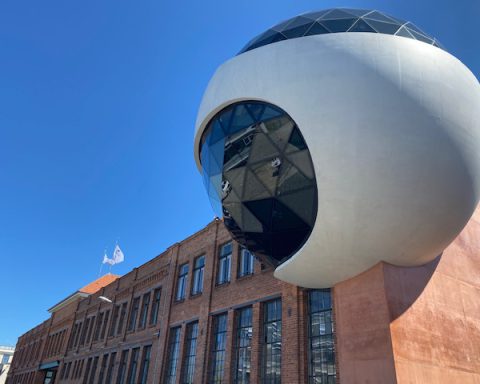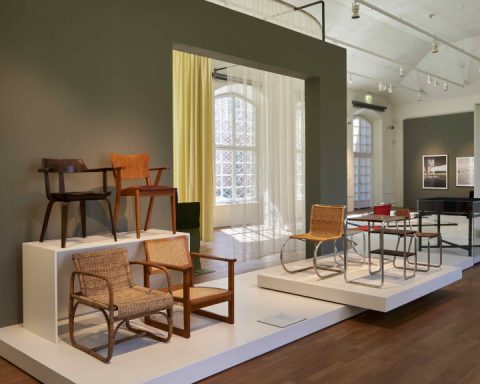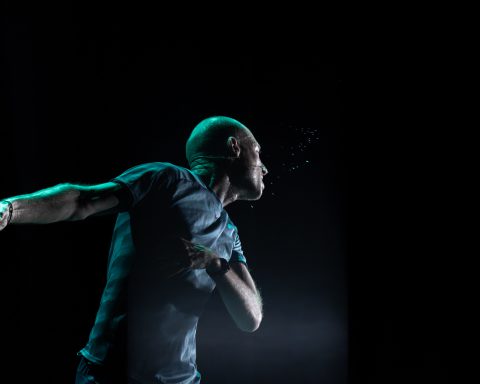
It’s always interesting to listen to and exchange ideas with Harald, the writer of today’s featured post. I think most people don’t consider these things when visiting a museum. This is deep, and definitely worth a read. Even though you may not agree with his views, his thinking might inspire you to more closely ponder on the way a museum – or any other place of public (re)presentations – is arranged and what messages it might be trying to convey beyond its readily viewable objects and descriptions.
—————————————————–
Reflections on a Visit to the Saxon State Museum of Archaeology
by Harald Köpping Athanasopoulos, Leipzig
When my father suggested to drive up to Chemnitz to visit the Saxon State Museum of Archaeology, I immediately got excited. After watching Indiana Jones, archaeology became one of my childhood passions and I also couldn’t wait to take the car for a ride down the brand new motorway A72 which links Leipzig to Saxony’s third-largest city in about 40 minutes.
The former Kaufhaus Schocken which hosts the museum is a highlight in itself, having been designed by Erich Mendelsohn, one of the pioneers of the Streamline Moderne-style of architecture. The exhibition itself is subdivided into three sections. The ground floor hosts a collection of finds reaching from the Neanderthals to the first modern human settlements. Going up the stairs one arrives in the section on the Palaeolithic and the Bronze Age. Finally, the top floor presents objects from the Medieval, the Renaissance and Industrialisation. I was particularly fascinated by the collection contained in the ground floor. It is incredible that there were actually large numbers of Neanderthals living right here in Leipzig 15,000 years ago. Most finds were made in the gravel quarries and open-pit coal mines which now contain Leipzig’s numerous lakes (Cospudener See, Markkleeberger See, etc.). I was thoroughly intrigued by the exhibition on the Linear Pottery culture which flourished in much of Central Europe around 5000 BC. Particularly interesting was a model of an ancient village with huge mysterious tree trunk-circles whose purpose is entirely unknown.
However, this model was one of the very few examples of a conscious and explicit interpretation of the finds that were presented. We have no idea what exactly a settlement of the Linear Pottery culture looked like – the model was an educated guess. Nevertheless, this model brought a museum to life whose appearance was otherwise sterile: the hand axes, spear-throwers, flint stones and bronze tools were in almost all cases neatly arranged in glass cabinets and wall displays in front of a white background. I felt uncomfortable during the entire visit with this choice of set-up, but at first I did not quite understand why it all seemed so weird. Although the ‘sterile museum’ is quite a common sight nowadays, it took quite a lot of introspection and reflection to figure out what was wrong.
The white background represents the view that human consciousness is a tabula rasa. We are all born with inherent philosophical neutrality, and all beliefs (ontology) and ways of knowing (epistemology) are the result of our exposure to them. To prevent becoming infected with bias, scientists thus ought to make an effort to remain neutral. When translated into a museum, the sterile representations similarly convey neutrality. The spectators are meant to walk through the exhibition and make up their own mind about the past. No ready-made stories are being handed over to them – or so it seems.
Underlying such an attitude to archaeology is the principle of positivism, which postulates that the processes and phenomena of the social world can be studied in a manner analogous to the tests and experiments carried out in the natural world. In these experiments the researcher herself has no impact on the object of study. Bacteria do not care about being observed under a microscope when they engage in reproduction. Similarly, a positivist anthropologist can supposedly make reliable observations about the mating behaviour of individuals belonging to a remote tribe. Her presence will have no impact on that behaviour. Furthermore, both the biologist (i.e. natural scientist) and the anthropologist (i.e. social scientist) can form conclusions about their observations from an ontologically neutral standpoint. If this is all assumed, an archaeological museum should be able to contain an exhibition that is free from ontological, epistemological and historiographical interpretations.
The point is that positivism is not neutral. The assumption that our sense organs, and only our sense organs are reliable sources of knowledge (i.e. empiricism) rests upon the idea that the material world is all that there is (i.e. materialism). The question of why the world exists in the first place becomes not just unanswerable but meaningless. The word ‘why’ does not appear in the positivist dictionary. Metaphysical questions pertaining to spirituality, psychology or morality are either rejected altogether or reduced to material processes.
The tabula rasa-approach to any museum thus implicitly promotes materialism. However, the Saxon State Museum of Archaeology takes this philosophy to an extreme. Behind the façade the sterile exhibits tell the story of human technological progress. It narrates the advance from the earliest tools to the pinnacles of human technology, from the stone axe to the telescope. We are told that when Galileo Galilei looked at the stars, he found that the earth is not the centre of the celestial sphere, that we in fact live in a rather insignificant part of Milky Way, which is just one of billions of galaxies. Through the discoveries that the scientific technologies enabled, the angels, demons, gods, heroes and saints that previously populated the heavens and the earth were reigned in, allowing for the rule of the human intellect. The world of early Homo sapiens was inevitably one that was dominated by spiritual forces, and the discovery of jewellery in Neanderthal graves suggests that other human species too had a concept of an afterlife.
Through the sterile representation of ancient objects we are reminded that the non-material world was always illusion. The disenchantment that came with the enlightenment was merely a recognition of the true human condition, rather than a process that was rooted in a particular (materialist) ontology. The reduction of human history to technological evolution is the historiographical manifestation of this materialism. This narrative can be sold especially effectively in a city like Chemnitz, where ‘actually existing socialism’ has only very recently been replaced by financialised capitalism. Both ideologies reduce human history to its material dimensions. Communism did so through its vulgar emphasis on class struggle, and capitalism through its fetishization of consumption. The change from one system to the other appeared revolutionary, but the underlying principle remained the same, albeit becoming less recognizable.
The Saxon State Museum of Archaeology has a lot to offer: a huge selection of local finds, a fantastic model of a village from the Palaeolithic, life-size models of human fossils, and a powerful yet subtle indoctrination with hyper-materialist ontology. I say it is definitely worth a visit!
 Harald is a Leipzig-born PhD researcher at the University of Liverpool Management School. His dissertation is about the role of European integration theory in the neoliberal transformation of the EU, using migration management as a case study. He has taught on subjects ranging from strategic organisation to international development in Liverpool, Paris and Angers. Apart from that, he is a Christian, a socialist and a political activist for the Social Democrats. Check out his political blog EUtopia (eutopia-blog.blogspot.com).
Harald is a Leipzig-born PhD researcher at the University of Liverpool Management School. His dissertation is about the role of European integration theory in the neoliberal transformation of the EU, using migration management as a case study. He has taught on subjects ranging from strategic organisation to international development in Liverpool, Paris and Angers. Apart from that, he is a Christian, a socialist and a political activist for the Social Democrats. Check out his political blog EUtopia (eutopia-blog.blogspot.com).









